BY JAMES GREENBERG
Photographed by Derek Hudson
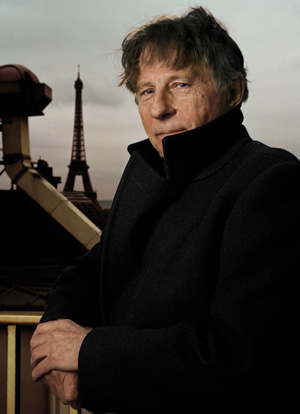 Talking with Roman Polanski in his office off the Champs-Élysées in Paris, he suddenly gets excited. He wants his assistant to pull up an image of Jan van Eyck's famous 15th-century painting of a married couple holding hands. He points out where, in a tiny mirror in the background, you can see the reflection of the artist working at his easel and the words "van Eyck was here" written above the mirror. That's the artists' eye. And, for his almost 50-year career, that has been the director's goal—to render that feeling of being in the room surrounded by the action.
Talking with Roman Polanski in his office off the Champs-Élysées in Paris, he suddenly gets excited. He wants his assistant to pull up an image of Jan van Eyck's famous 15th-century painting of a married couple holding hands. He points out where, in a tiny mirror in the background, you can see the reflection of the artist working at his easel and the words "van Eyck was here" written above the mirror. That's the artists' eye. And, for his almost 50-year career, that has been the director's goal—to render that feeling of being in the room surrounded by the action.
Whether it was the overconfident operative in Chinatown, an agitated young wife in Rosemary's Baby, or the 19th-century hard luck heroine in Tess, Polanski has used his artistic vision and technical skill to make the audience feel like they were alive in that time and place, that moment. For The Pianist, he stepped back to allow the horrors of the Holocaust to speak for themselves, and was rewarded with a DGA nomination and an Oscar for best director.
Polanski must be a wonder of science—or genetics. At 75 he displays the same tousled hair, youthful physique and acutely active mind he had in our earlier conversations 15 years ago. His prominent nose and narrow eyes still give him the wary gaze of a wolf, a demeanor he may have acquired in his early years dodging the Nazis in his native Poland.
Polanski, who, shortly after my visit, filed a court document to dismiss the legal case that has kept him out of the U.S. since 1978, says he prefers to only talk about his work. And aside from a few opening remarks about his current situation and a lunchtime digression into American politics, that is what he did with humor and intelligence over the course of two days. Here's what he had to say about his long and eventful life in film.
James Greenberg: Let's start with some current events. The legal problems that have kept you out of the United States since 1978 have been fairly high profile lately with the release of the documentary Roman Polanski: Wanted and Desired. What did you think of the film?
Roman Polanski: I saw it very late, actually. People were telling me about their impression of it and I thought, are they exaggerating or what? I was impressed with it, first of all, as a movie. It's just a very well-made documentary, very objective, very honest, very interesting. For me it has a special value because I discovered things that were totally new to me, and if they were known 30 years ago the whole case would be over in a week.
Q: What was surprising to you in the film?
A: What was surprising was that one of the district attorneys had unauthorized meetings with the judge and was influencing him illegally, and that sending me to the prison in Chino was the district attorney's idea, and all that happened without the defense present, which is illegal. And then there was the scene where the DA says he understood why I left.
Q: What was it like for you to watch it?
A: It was powerful. It's that for the first time someone is telling the truth instead of the myth that was like a snowball rolling for all this time because reporters picked it up only on the Internet [from other stories], added a few things, and sent it off. I have not seen one article or book that brings up the truth about my problems. Not necessarily because they intentionally lie, but they're simply not interested in finding it.
Q: Could you conceive of ever working in America again or would the media circus just be too much to deal with?
A: I am afraid the media would be too much. I don't think it would be hardly livable. I don't know; it's all just supposition.
Q: Is it something that you'd like to have closure on?
A: Definitely. Of course I would like this for peace of mind.
Q: You've said that your passion is moviemaking and you're happiest when you're in the middle of it all. Do you still feel that way with all that's happened?
A: Yeah, absolutely. I realize that the best moments for me are when I'm on the set where I feel happy in spite of the aggravation. But of course it depends very much on the production. Sometimes it's hell. I had moments several times in my life when I thought I'd better change professions. Much of the time, not only for me but for most directors, our energy is soaked up by all kinds of problems which have nothing to do with filming.
Q: When did you start thinking about being a director?
A: I always wanted to do that. That was my prime interest, and I don't even remember the beginnings of it all. I remember when I escaped from the ghetto, I was living in Krakow with a Catholic family and I would go to the cinema. These were all uninteresting German films. To go to the cinema was very unpatriotic and there was graffiti on the walls of cinemas, "Only pigs go to movies," but I didn't care. I would sell newspapers to get a few pennies to go to the cinema. It was an escape and I was completely in love with all of it. With the room and the seats, the atmosphere and the smell, the beam of the projector and, principally, with what was on the screen.
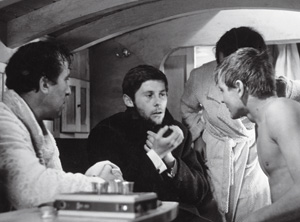 For Knife in the Water, his claustrophobic first feature, Polanski
For Knife in the Water, his claustrophobic first feature, Polanski
used only three actors and shot mostly on a boat.
(Photo Credit: Roman Polanski Collection)
Q: Did you have artistic tendencies as a kid?
A: I had a chance as a kid to get a lead in a play and it was a success, so that put me in this category of kids who do something different. Then I wanted to continue as an actor, but I was not accepted to any acting schools. So I really struggled a lot. Then I had a chance to get in to the film school. But I also went to art school, I did my baccalaureate in art. Painting, drawing, sculpture, graphics, all that. That gave me a good basis for what I wanted to do later, which is film directing.
Q: As you got older, what films influenced you in a more serious way?
A: The first film that had a great impact on me and I feel I'm always trying to copy is Carol Reed's Odd Man Out. The whole atmosphere, strangely enough, resembles very much my childhood city of Krakow, with the change of seasons that can happen in one day. That atmosphere seduced me, and then I thought of the acting, of the photography. And then I realized much later that there was something deeper in the story [that attracted me]; it was the story of a guy who is a fugitive. And, you know, I was a fugitive from the ghetto.
Q: You made your first feature, Knife in the Water, which was nominated for an Oscar but wasn't well-received at home and you left Poland immediately. Did you have that feeling all along that you were going to have to leave?
A: I always wanted to leave. Believe me, I was not the only one. The youth and the artists of that period were all dreaming of going west where you could really work and develop freely. I was born in Paris and my parents returned to Poland when I was 3. And through my childhood all I heard from my parents was Paris, so it was some kind of a myth for me. So obviously my desire was to go there.
Q: The setup for the film—three people on a boat—is very claustrophobic and precise. Was the way you were telling the story more important to you than the story itself?
A: When you finish film school you want to be original, you want to do something different. So it seemed then that story was old-fashioned. But once you get over that exercise you realize that first you have to know what you want to say and if you have nothing to say, you better shut up.
Q: Did you do the framing and the composition of the shots yourself?
A: Yeah. It seemed to me completely natural that the director would do the framing and it still does, in fact.
Q: Some directors defer to the DP.
A: Yeah, they certainly do, but I don't.
Q: Most of the film was shot on the boat but it doesn't look shaky.
A: Who likes shaky? I mean, shaky is for the masturbators. When you watch life around you, is it shaky? It's shaky maybe when you are on a helicopter or on a speedboat, but not when you observe what's around you from terra firma, even on a sailboat.
Q: You've said that the lesson you learned on Knife in the Water was to rehearse, observe, and shape, and you've applied that ever since.
A: Absolutely. That's how I work. There are probably many other ways to skin the cat, but I feel comfortable by doing it my way, which is to rehearse first and then decide how I'm going to block it and how I am going to film it. As the director, I'm the observer. So at the beginning I try to interfere as little as possible, but to notice there may be things that are wrong—that they may be either too difficult to film or the way they evolve within the scene is not interesting or not real. So that's my job, to render it filmable.
Q: How does this approach affect what you do with the camera?
A: Sometimes students or young people ask me how to be practical on the set. I try to always impress on them that they should not attach too much importance to the camera itself. There's often a notion, particularly with beginners, that the camera brings a kind of magic to the set, that everything happens around the camera and for the camera. And to me, it's just the opposite. The camera is there to film what has been staged, and it should not be staged for the camera. Very often you see young directors place the camera and find a beautiful angle and then try to fit people into it. It's just like buying a beautiful suit and trying to fit a person into it.
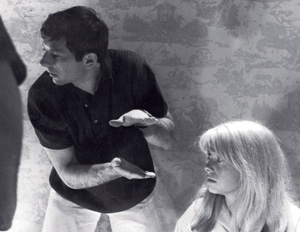 Polanski shows Catherine Deneuve how to go convincingly
Polanski shows Catherine Deneuve how to go convincingly
crazy in Repulsion. (Photo Credit: MPTV.net)
Q: Your early, low budget films—Knife in the Water, Repulsion, The Fearless Vampire Killers—all have the feeling that you're figuring it out as you go. Do you ever miss that freewheeling style of working?
A: Yeah, I must say I do. But I like what's happening now very much, actually. Anything that goes through your head, you can put on the screen. Before, there were certain things that were just impossible. With CGI you can decompose the image into pixels and the pixels can be organized any way you fancy. God, how many things I could have done so much better if I had that! With Repulsion, for example, I had certain surrealistic images in my head that I could not express with the technology of that period. Nowadays you can do it fantastically well.
Q: I assume you're thinking of the scene where the hands come poking out of the wall as Catherine Deneuve is losing her mind?
A: Yes, the hands in the wall would be so easy. Warping is one of the manias they exploit with relish in CGI.
Q: What other things did you use to suggest her deteriorating state of mind?
A: As she starts hallucinating, I wanted to have the feel of the place getting bigger and having her lost in the middle of it. So we decided to build the set of the living room and also the bedroom in such a way that we could open up the walls. The flats were larger than the rooms, so you could move the flats farther out, making the room larger. Also, from the start I told [my DP] Gil Taylor that I wanted to use wide-angle lenses, and Gil was always joking that it's a crime to distort such a beautiful face as Catherine Deneuve's by coming in close with the wide angle.
Q: The closing shot of the film, in which you dolly in on a family photograph of Deneuve as a child, explains a lot about her mental state. It's a haunting shot and has been widely imitated.
A: In those days, to actually execute this type of shot was very difficult. The dolly did not have the same mobility that it has now and the zoom, if I remember, was hand-operated, so to get it really smooth wasn't easy. And then to be steady enough to have it zoomed in a little further in the lab was a tough job. It was a great headache and it took the whole day to get this shot.
Q: Well it's effective.
A: Apparently it was effective because the reactions were positive. But the film was made on such a shoestring that I feel upset seeing it because it was not as I wanted, simply because we did not have enough time or money to do it to my satisfaction. So I think the film is quite shabby.
Q: After making three films in England, you went to Hollywood to make your first American film, Rosemary's Baby. How did that come about?
A: Well, Robert Evans called me with a proposal for a skiing picture, Downhill Racer, and since skiing is my sport I was eager to do a film about it. So I came to Los Angeles and he handed me the script and also a bunch of long strips of pink paper which were the proof of Rosemary's Baby. And he said, "Read this first, please." I went back to the Beverly Hills Hotel and started reading it, and around four in the morning I was still at it. So the next day I came back to the studio, and said, "Okay, let's do it." And that's how it came about.
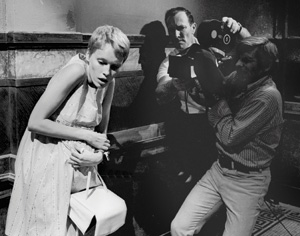 DEVIL'S WORK: Polanski, shooting Mia Farrow, says Rosemary's Baby
DEVIL'S WORK: Polanski, shooting Mia Farrow, says Rosemary's Baby
was the first time he felt totally in control of the filmmaking.
(Photo Credit: 1978 Bob Willoughby/MPTV.net)
Q: One of the interesting things about Rosemary's Baby was the casting of a bunch of old Hollywood actors—Ruth Gordon, Sidney Blackmer, Ralph Bellamy, Patsy Kelly—in supporting roles. How did you find them?
A: I used to sketch what I thought the characters should look like and then give that to the casting people, and they would come back with actors and I would choose. Even now I do it a bit, but not as much as then.
Q: Perhaps the most memorable scene in Rosemary's Baby is the long dream sequence in which Rosemary is impregnated, possibly by the devil. How did you do that?
A: I was trying to use things I remember from dreams: one, that they are very quiet, almost silent, even if somebody is screaming; two, that people change. The person you're dreaming of is suddenly not the person you started the dream with, but has somehow evolved into somebody else. Those are the elements I was trying to represent in those sequences. And we used pre-flashed negative to give it a different texture. Today it would be easy. You would look it up on your computer and play around with the buttons. But in those days you would have to anticipate the effect, make tests, and so on.
Q: For years, I thought I saw a glimpse of the baby at the end of the film, but apparently it's not there.
A: You thought you did? Well, that's good. It shows that you can act on the imagination of the spectator; you're creating certain illusions or whatever. I could not make a film that is seriously supernatural. I can treat it as a comedy, as a tale, but as a realistic event in today's New York where a woman is raped by the devil? No. I can't do that. So I did it with ambiguity.
Q: One of the things that make Rosemary's Baby or Chinatown or any of your films so believable is the attention to the details of that world.
A: I think that details pay off, period, whether it's movies or any other art, particularly in performing arts. So lack of attention to the details is simply sloppiness. I have to have a script really well-worked on so there is no time wasted when you're on the set. And I also spend a lot of time with the production designer on the details of the sets to be sure they follow what I have anticipated working on the script; that it's not just his own creation which has no relation to the way the scenes have been devised and anticipated. It's important for me that if I imagined a room with a door on the left and window on the right, that it's not the opposite.
Q: The production designer Richard Sylbert, who you worked with on Rosemary's Baby and Chinatown, was obviously someone who was important to you.
A: I remember seeing Baby Doll in film school and thinking, "Who made that fantastic set?" So I knew about Dick Sylbert long before I met him. On Chinatown, I was insisting that the ending should be a scene in Chinatown, which was not in the original script. Otherwise the title only has meaning as a symbol. So since the producer of the film, Robert Evans, insisted I come up with something, I asked Dick to make a street look like a Chinatown street because there was no Chinatown per se in Los Angeles at the time. So we found a street that had some Chinese restaurants that you could easily adapt and Dick made it look like part of Chinatown. He was fantastic at that. He was really the greatest, I must say.
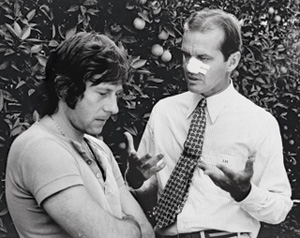 The director and Jack Nicholson work out the details of the
The director and Jack Nicholson work out the details of the
orange grove scene in Chinatown. (Photo Credit: Kobal)
Q: What were the other changes you had to make to Robert Towne's screenplay?
A: We worked on it for eight weeks and restructured it, shortened it, eliminated certain characters, put together others, and ended up with what we have now, more or less. We could not agree on the ending and on the love scene. Towne didn't want them to sleep together and he didn't want the girl to die at the end, and we had some disagreements about it. But we had to get into production, so I wrote those scenes in the middle of the film. I wrote the end scene and took it to Jack's trailer on the night of the shoot and asked him to revise the dialogue so it sounds like his style. I was always convinced that it was the logic of the piece, if you want to have any feeling of injustice you have to take it to its end. I also thought if the girl goes at the end, they should have a one-night stand. It has to be something stronger between them, not just a platonic fantasy.
Q: How did you handle the scene where Nicholson nearly drowns in the runoff from the reservoir and gets pushed up against a wire fence?
A: It was a stunt that I asked Jack to do. I remember that he was playing it cool, but of course doing a thing like that you have to be a little bit stressed. And he had a rubber suit under his usual suit. And I recall just before the shot he held up a finger. I didn't understand and I screamed, "What?" He yelled, "One!" I said, "What one?" "One Take!" [Laughs]
Q: How did you direct the scene where Nicholson slaps Faye Dunaway? That's a key moment in the film.
A: It's always very difficult to give the essential information without making it feel like exposition. So I thought of the slapping. I thought if she is forced to give it, you avoid that feeling. I think we did a few days on it because Jack was reticent, slapping his lady partner. But Faye was encouraging him to do so. At one moment, he hit her quite hard, and the sound makes it seem harder. In things like that Faye was a trooper.
Q: It's been widely reported that you didn't always get along with her.
A: For the look of her character, I remembered my mother plucking her eyebrows and putting lipstick on in this cupid bow shape, which was the fashion at that time. And I told Faye that I wanted her to look like this. And she thought it was a terrific idea, but to such an extent that she went completely berserk with this, and after every take she would redo that goddamn makeup and the lipstick, which took forever. Ahh! It became a nightmare because sometimes I would cut in the middle of a take and she would go through all this ritual again. Blistex, lipstick, powder, and so on. So the crew made a huge tube of Blistex and gave it to her on her last day.
Q: One of the things you do, in Chinatown especially and you've used in many of your films from early in your career, is to position yourself as the director inside the story and see the film subjectively. Where did that tendency come from?
A: I don't know what influenced any specific film. But Olivier's Hamlet had a big impact on me when I was in film school. It was just so different from anything I'd seen. That maze of interiors and the camera kind of floating around with this fantastic music. So I was drawn to films where the action happens within the walls and it's not flat in front of me. I much prefer a film which gives me the feeling that I'm in it rather than watching a cavalry chasing on the field and battle scenes in which you don't know who is fighting whom. So I was attracted to this type of film.
Q: How did this strategy apply to the Gittes character in Chinatown?
A: Chinatown is very much this type of narrative because it's completely subjective. So you should feel like you're in Gittes' skin and seeing it with his eyes. It's a bit romantic, so you can indulge in a certain dance. It flowed and I often had the camera over his shoulder and you discover things with him. So you walk into a room with the character. In general, I hate to precede someone into any room. I don't want to see the character come into an undiscovered location from the front. I want to go in with him.
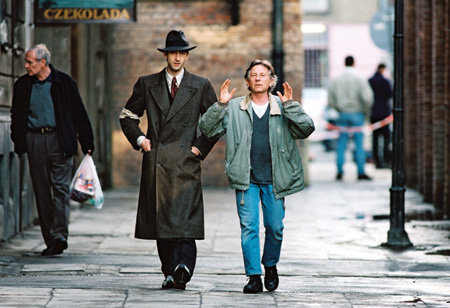 Polanski, with Adrien Brody in Warsaw, says all his films seemed like
Polanski, with Adrien Brody in Warsaw, says all his films seemed like
a rehearsal for The Pianist. (Photo Credit: Focus Features)
Q: But for a film like The Pianist the visual approach is quite different.
A: It's different for every film. Sometimes you know well ahead of time how you want to use the camera. For The Pianist I had a lot of conversations with [my DP] Pawel Edelman on the subject. I stressed to him that I don't want to feel or see any camera movement, that we should somehow give the feeling that you get by watching documentaries of that period. Someone watching the film should be absolutely unaware of the director. In Chinatown you can indulge in a certain dance. But not in a film like The Pianist. It would be indecent.
Q: So technically did you use low key lighting and low-key camera in The Pianist to keep it that way?
A: Yes, as a director, you just stand back. I just wanted to avoid the things that I usually like very much, to be this curious observer just lurking above the shoulder of the central character. When the film opened in France they criticized me for it, but I was delighted with how I managed to hold back like that. I didn't want to make a motion picture drama out of it. I just wanted it to happen as it was, in a casual way just progressing. It just becomes a gradual hell.
Q: How much of your personal experience did you draw on for The Pianist?
A: Throughout the film there is the echo of my own experience. It's the Warsaw ghetto; I was in the Krakow ghetto. That was the thing that worked for me. I did not want to ever do any kind of autobiographical film about my childhood during the war. But I did want to use that experience in a motion picture on the subject. Reading Szpilman's book, I said, 'This is the time. If I don't do it now, stories like this one don't come along that often.' So throughout the film I use bits and pieces of what I remember.
Q: Can you be more specific?
A: I remembered a moment perfectly well in Warsaw before we went back to Krakow. I was with my father on this street and we saw the Germans marching, impeccable in their uniforms. And my father squeezed my hand and said, 'mother fuckers, mother fuckers.' And that's how I recreated that scene. And the scene where the father is slapped. One day my father came home and his ear was bleeding and he told us that there was a German officer who stopped him and said, "Why didn't you bow?" and hit him on the head. Some silly people say, "Why didn't Jews rebel?" Well, they did rebel, but it doesn't happen like it happens in the movies. Things happen gradually and you always think that it won't be worse.
Q: I wanted to ask you about the scene where Adrien Brody steps out of the house after he's been in hiding and the city is in ruins as far as the eye can see. How did you create that look?
A: Well, this is from another of my own experiences. After the war, I was working in the theater and had the lead in a Soviet play, and was taken to Warsaw with this company and that's what I saw: The city was flattened. So from the beginning I said I must have this scene in the film. And we went through various projects figuring out how to do that scene. And I realized that if I did it CGI, it will never be that way because you just can't recreate it. So we found some Soviet barracks near Berlin that nobody wanted to live in and made a deal with the owners to destroy those buildings. And Allan Starski, the production designer, just went from house to house and destroyed it the way he saw it. And that gave us the main street and also plenty of other angles and positions for the rest of the movie.
Q: With all this history, was it emotional for you while you were shooting or were you just too consumed with the filmmaking?
A:The only thing that moved me was the work of the extras because that was so extraordinary and something totally unexpected. Otherwise I was completely busy. Certain dramatic scenes are satisfying because of the mechanics of it. Like the crazy German officer when he shoots the people lying on the ground. If you see that the actor is awkward with the gun, it doesn't work. So when the guy does it well, when all the special effects people and the propman and the actors do it well, I'm happy. But it doesn't move me because, for me, it's artifacts. It's phony for me. But the fact that it functions is enjoyable.
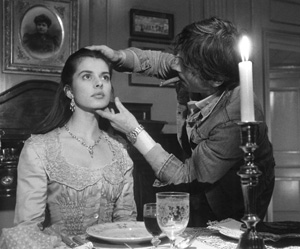 Polanski positions Nastassja Kinski just so in Tess.
Polanski positions Nastassja Kinski just so in Tess.
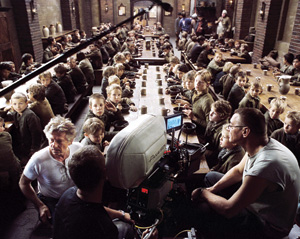 Working with kids on Oliver Twist was easy for Polanski—the dog, he says,
Working with kids on Oliver Twist was easy for Polanski—the dog, he says,
was another matter. (Credits: (top) Roman Polanski Collection; Everett)
Q: You've done a few period literary adaptations—Tess and Oliver Twist. What's the challenge of doing something like that?
A: The challenge is the exactitude. You just have to do a lot of research and try to recreate the period as honestly as you can and not just fix it to your needs. This way you avoid that Classics Illustrated effect. The author always writes it in his reality, that's his world. He is not recreating, I am. So if you try to do everything the way it was at that period, not only the costumes but all the other details, all the props and elements of people's behavior, their body language, etc., it becomes real and it's more than just an illustration. You just must not accept the traditional way that things are presented to the public.
Q: The seduction scene in Tess doesn't look choreographed as so many sex scenes do in films. How did you get around that?
A: Just rehearsed it. You see what the actors do, then eliminate the things that look phony and develop things that look original or interesting or real. And usually the camera gives an extra stimulus to the actors. Same with the theater. The curtain goes up and new things happen.
Q: You've shot more than your share of love scenes; is that something you like doing?
A: No, I don't like them. You know, unless something dramatic happens in the middle of it, like the roof collapses or something, it's pointless showing it. We've seen it in all colors already. It's boring and embarrassing, to a certain degree. People somehow always feel uneasy in the theater. It very seldom has any kind of dramatic point in the story. The more daring it is, the phonier it looks. Because you're always asking the question: Did they do it for real? Did he have a hard-on? What kind of protection did they use? Your mind goes in completely the wrong direction. So what do you do? Pan on the fireplace? [laughs] Pan on the window, pan on a flowerpot. It's difficult to get out of it in an original way. It's all been used.
Q: Having to work in Europe all these years, do you feel like it's limited your access to the kind of material you might have wanted to do?
A: What it limits is the direct contact with people involved in the industry. A lot of things just happen in restaurants and cafeterias—a lot of ideas, a lot of projects, a lot of friendships. I am cut off from that.
Q: Now you're getting ready to shoot a new film, Ghost, in Germany. What is it about?
A: It's what they call a political thriller, based on a book by Robert Harris. The story is about a ghostwriter who is hired to help a former British prime minister write his memoirs because the previous ghostwriter died in a drowning accident. And he starts working on it in the winter in one of those summer resorts on the American coast and gradually discovers the reasons for the death of his predecessor. Ewan McGregor is the ghost and Pierce Brosnan is the prime minister.
Q: Sounds like perfect Polanski material. Does it seem like a difficult shoot?
A: Not to me. But every film seems to be difficult, even when you're not expecting it. You never know where you're going to end up.